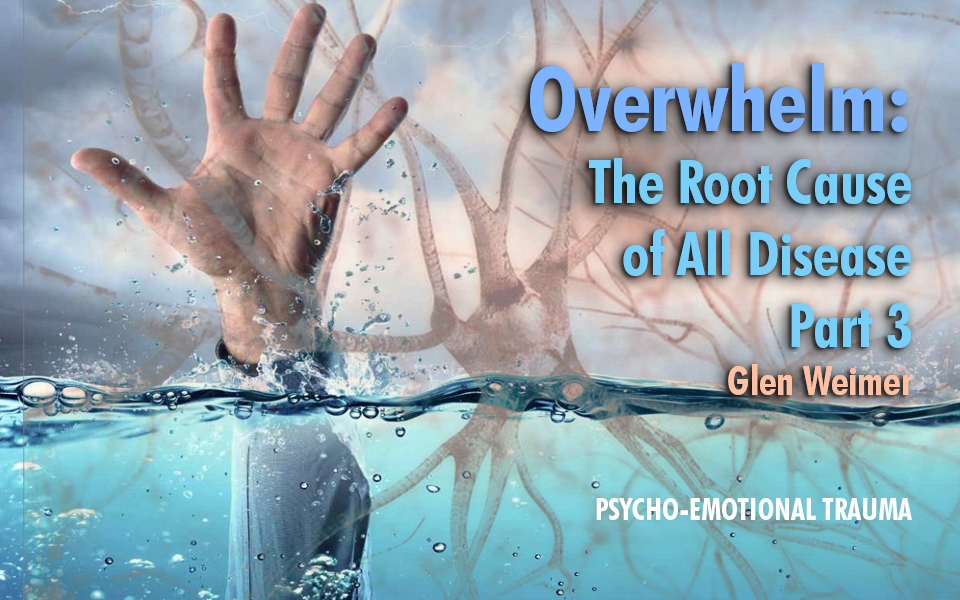Please note: this is the third of a 4-part blog. (see Parts 1 & 2)
Psychological & Emotional Trauma
Let’s talk about these two types of overwhelm together since they often go hand-in-hand. Psycho-Emotional Trauma (overwhelm) is not so much what happens but how we perceive what is happening to us. It’s an emotionally charged moment in time or period of time when we don’t have what it takes to get through it. The message to the self is “Oh my God I’m going to die!” The feelings are HUGE!
Sigmund Freud defined trauma as “a breach in the protective barrier
against overstimulation, leading to overwhelming feelings of helplessness.”
Of course physical, emotional and sexual abuse can all be deeply traumatic, but common events can be as well; overhearing one’s parents arguing; having too much work to complete for a deadline; not having enough money to pay the bills are just a few examples.
The trauma lies in our perception of a situation. At the moment of trauma, an individual is unable to handle what is happening in the current moment, so the system records the entire event internally to be dealt with later. In that movement what we are lacking are the appropriate resources, (there weren’t enough people around to help; or the “right” person; or we didn’t have enough internal capacity to face it; or we didn’t know how to act to make things better). (see my blogs on Resourcing and Polyvagal Theory, parts 1-5)
By this definition we have all been traumatized, at some time in our past or present we have been overwhelmed by everyday life.
The Sympathetic activation part of Trauma feels like we have one foot on the gas petal and the other on the break. Our engine is revving full-throttle but we’re not going anywhere which is why people report feeling shaky inside. That’s our revving nervous system. The disconnect is between our dire need to act and inability to do anything.
What is going on neurologically is that the Autonomic Nervous System (ANS) has diverted energy and blood supply away from the core of the body, from the digestive and reproductive systems and sent it out to the big muscle groups to mobilize and fight or run away from a threat. If we can’t adequately respond and become overwhelmed that pattern locks into our nervous system and tissues. Here, we’ve dropped into our Parasympathetic Nervous System’s (PNS) immolation response. Afterward we may experience persistent pain in a specific part of the body where we encoded that memory. Healthcare providers often can’t find the cause of the problem and consider it psychosomatic. It’s not REALLY all in your head, in actuality it is in your nervous system and tissues.
The entirety of that moment (sights, smells, thoughts and feelings) gets frozen internally, like pausing a movie, to be dealt with later, when the threat has passed and looking at it or dealing with it won’t kill us. Remember the internal message is “Oh my God I’m going to die!” Since we didn’t actually die, our system uses pain to get our attention to look at where in our body we stored those overwhelming feelings and dissociated parts of our self. It’s for this reason people who were abused as children often have no memory of the incidents until later in life and why so many veterans return from war with PTSD. Our BMS is brilliant at waiting until our lives are relatively safe and stable before bringing up this trauma to be healed—it’s desperate for that part of our psyche, frozen in time, to be reintegrated into our wholeness. And when we do, it liberates enormous energy, energy that held onto that pattern often for years.
The distinction I make between Psychological and Emotional Overwhelm is that in Psychological Trauma we can’t make sense of the story so it gets stuck in a perpetual loop that we play over in our minds—“I just don’t understand why he would do that to me”, whereas in Emotional Trauma we can’t come to terms with the feelings that we are experiencing, or they just feel too big.
Continue reading. Go to Overwhelm: The Root Cause of All Disease – Part 4
Disclaimer:
The information featured on this site is provided for information and education purposes only and is not intended to replace the advice of your doctor or health care provider on medical and/or health-related issues.
You should not use the information on this site for diagnosis or treatment of any health problem or as a substitute for medication or other treatment prescribed by your physician or health care provider.
Submit your review | |



